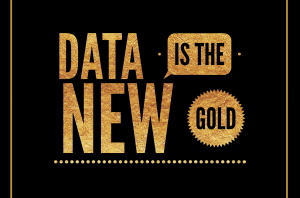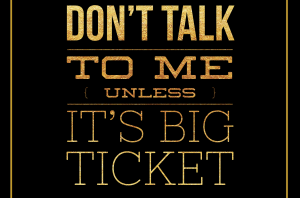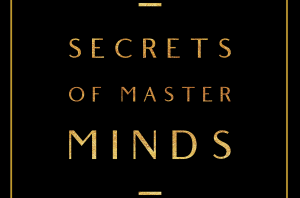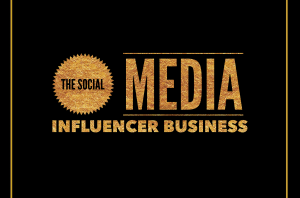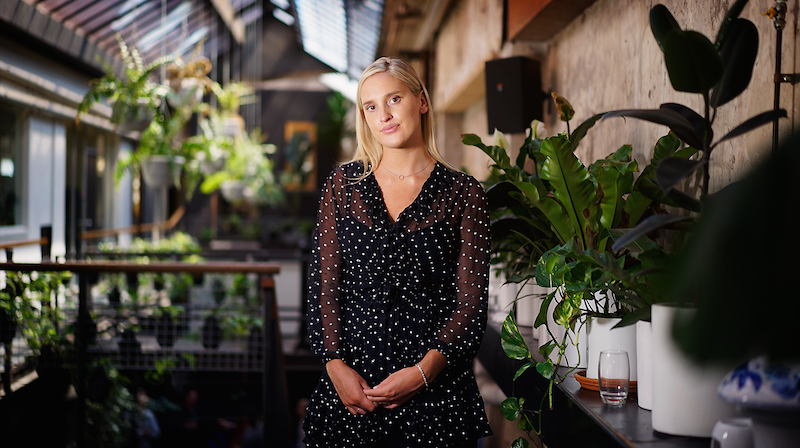
Gretta Rose van Riel is a prolific start-up starter. Her first e-commerce company, SkinnyMe Tea, scaled to 600k/month in 6 months, coined the term “teatox” and won Shopify’s Build a Business competition in 2013. It now boasts 300,000 loyal customers worldwide. She then co-founded The Fifth Watches, which brought in a staggering 1M USD in a day on December 5, 2015. Her other companies include DROP Bottleand Hey Influencers, a platform that connects brands with influencers.
Her combined Instagram following, including vertical accounts including (@vines, @befitfoods, @detoxwater, @detoxtips, @nutrition_planet, @smoothiebowls) is over 16 million and counting.
I had the honor of sitting down with her for an intimate chat about her journey, how she turned failures into learnings, what it takes to own and operate a business, and how you can start and scale your own e-commerce store.
Tell me about what you were like as a child. What did you love doing? What was your favorite school subject?
I’ve always been a bit bossy. I was a crazy kid! I loved nature; super into swimming and the beach. We had a beach house in Phillip Island and I was very carefree up until high school. We moved from a laid back, left-wing, carefree primary to a conservative high school education, where I didn’t know anybody. It was a huge shock, and left me feeling like I was playing catch up. This made me put more pressure on myself to achieve. I started swimming competitively, training 5-10 times a week and every day in the gym. I swam at a national open level. It was a lot of pressure, but it helped with discipline and routine. Here I became process-driven.
Swimming and moving to a regimented high school were the two main turning points in my self-motivation. I’ve always been very self-motivated, which is why I haven’t done a lot of media stuff prior to Start and Scale. I’ve always focused on achieving my goals in my startup as opposed to talking about it publicly. My motivation comes from within as opposed to externally, like people saying that I’m an inspiration (which is lovely of course)!
I studied media and communications at Melbourne Uni, which is quite a difficult course to get into. Only 90 accepted were accepted a year, and your year level is the top 3% of the country. You were collaborating with really bright minds, getting pulled up with them. I worked really hard during that degree, did well, and deferred for a year to travel.
At the time I was working as a lifeguard, but realized that with my new undergrad degree, I could get some solid paid work. I went on SEEK for digital marketing positions, filtered highest to lowest paying, and ended up getting 2 jobs. I chose a digital marketing position at a print transitioning into a digital media agency in the city. There I headed their digital transition, going from lifeguard to digital head at 21. My family was super happy, being all like: “This is your dream job!” I was there for only 3 months before starting SkinnyMe Tea. I worked on developing really engaged communities at this job, and did that on my own at home on the side.
SkinnyMe Tea started gaining followers that weren’t my friends or family, and back then that was a completely new way of interacting on social media. In the past, on MySpace and MSN, it was all people you knew. It was a friend-based economy as opposed to an interest-based economy. I enjoyed Instagram’s interest-based economy as it has plenty of potential to build niched, engaged communities.
SMT brought in 600k USD/month in just under six months. How did SMT begin, and how did it escalate so quickly in just under a year?
When I came up with concept of SMT the first thing I thought of was to start an Instagram account. In May 2012, no businesses were on Instagram yet. 90% of the time, people would follow back. There were no rate limits back then either, I’d follow 4000 people in a night as I was watching TV.
I asked myself: “Who is my target audience?” And the answer was me and my friends. Young, health-conscious but not health-focused girls aged 18-24. I followed me, my friends, their friends, until I followed every person in Melbourne. Then I moved onto Sydney. Melbourne and Sydney were the two main cities I followed, and 5 years later, are the 2 main cities in the world that purchase from us.
From 0-6 months, SMT grew to 600k USD per month. It was just insane. When I was a lifeguard, I made 20k a year. With SMT, I would start making my weekly wage in a day, then my monthly wage in a day, then my monthly wage in a hour. I felt like it was such a fluke, or luck, a case of being in the right place at the right time, so I wanted to figure out exactly where our growth was coming from. I want to replicate the growth again. In the end, it was all down to the captions and call to actions that was generating so many sales.
Back in 2012, one girl from Tasmania had 1000 followers posted our tea and made the most sales we ever had in a day. After that, I’d screenshot every girl with over 1000 followers and reach out to them with our tea. We were the first teatox company in the world with zero competition. When we reached out to girls, they were so not used to being approached, 90-95% influencers were stoked to do it. They weren’t used to VIP treatment, no companies were sending out free stuff back then! We were one of the first brands, if not the first, to pursue influencer branding at the time. When we started there wasn’t even a place to put a website link in your profile.
We won the Shopify Build-a-Business competition in 2013. They flew us to NYC, to meet the likes of Tim Ferriss (4 Hour Work Week), Eric Ries (The Lean Startup), Daymond John (Founder of FUBU).
Because of all the press and PR and who Shopify’s audience is (wantrepreneurs who want to start their own ventures) 50-100 copycat companies would pop up right after the competition. It created so many competitors. At the start I’d feel sick thinking about the competition but now I feel differently. My biggest fear with SMT was that it was a trend that’d peak and drop. What if it went away tomorrow? It’s every entrepreneur’s fear. What ended up happening instead was the competition; rather than taking sales (which yes they do), created a market. Rather than detox teas being a trending product, an entire marketplace of teatox companies flourished, and the trend continued a lot longer than it would have because of that. It was a positive thing retrospectively.
On December 5, 2015, The Fifth Watches’ first birthday, Gretta and co-founder Alex hit 1M in sales in just one day. How did they do it?
We launched purely through Instagram, made a waitlist there and sent out 30 watches to influencers before launch. Selling for 5 days a month was an accident, after the watches sold out so quickly on early orders.
“We did $100,000 on day one of the business and we sold out of all our product, which is why we started the five-day sales model,” says Alex. “We’d only have product for sale for five days and then we’d restock on the fifth of the next month. And they kept selling out. That gave us the opportunity to have a conversation with our audience for the next 25 days. If we’re selling 100 pieces, and those 100 sell out — which we do expect will happen — then after that, they could vote to bring it back.”
It took only five minutes to sell $200,000 worth of product, in one instance, including its signature best-selling gold-and-peach watch.
“Seeing 4000 (shoppers) on the site at the one time trying to buy a product is crazy.”
Take me through your business process. How do you decide which of your ideas are good enough to go through with – what is your criteria when looking for type of product?
I have 50 undeveloped business ideas at all times. I re-prioritize and change all the time. Every product I have ended up pursuing, came with an entirely different feeling. It’s been like – I can’t not pursue that. Sometimes two things come together and I get an “aha” moment. I have to act upon it right away. It wasn’t until I thought of the word teatox (detox + tea) that it had to happen.
I could feel the idea turning around in the back of my head, and suddenly it came together. What it looked like, what I would do, how I’d create it.
All of them have been a strong pull and feeling. That’s the only time you should start something, is that you can’t notstart it. Entrepreneurship and owning your business is not easy at all. I heard the guy from Angel List talk at a conference once and he said “Entrepreneurship is like getting up each morning and chewing glass. Only do it if you can’t not do it.” It needs to be passion. It can’t be: “How can I come up with an commence idea?” You’re not gonna get up every morning and do that company/idea unless you’re overwhelming passionate about it.
Where do you manufacture and how?
I started buying singular tea/herb packages at cost price, and then blending them together myself, making my own blends. Then we went and bought tea straight from supplier. Then we found where it was manufactured, which was in NSW. We kept skipping production line until we found main source supply. They were buying all the best quality herbs internationally, so we wondered if we could gather them ourselves. That’s where we’re at now, but between that we were like:
I moved to Hong Kong to live for a year. We started talking to Chinese manufactures, ordered a couple samples from one. They were great! We had them quality tested in China and Australia as well to cross-check. We ordered a small batch of units from him, then a slightly larger batch, and then I screwed up. I hated logistics. I was like what if we had a year’s worth. We weren’t deliberately feigning the scarcity model, we were constantly going in and out of stock, so as soon as we’d come in stock they’d buy it all. Our biggest problem was keeping up supply with demand.
So I ordered year worth of tea, it was 1.3million USD. It was all perfect at this stage. I was close with him, I’d take his daughter out shopping. We had a good personal relationship. We got the tea, we stored it in our Hong Kong warehouse, then shipped it out to Australia. It was over a tonne of tea that got stuck in customs. It took a further 80k USD and another two weeks just to get it out of there.
When we finally got it to our Melbourne warehouse, it was moldy compost. It had metal bolts and screws in it. It was absolutely horrific. We could tell we didn’t even need it tested but we sent it off to lab for a laugh, and it came back full of disease. It had ecoli! We had to throw the entire 1.3m USD worth of tea out.
It cost another 15k just to throw it out.
The main issue though was opportunity cost. We thought we had a year’s worth of tea in our hands, and so stopped working with other supplies. There was no backup. We were 3 months behind, and was forced to start mixing it by hand again. Not only did we lose money, we lost even more going back to a really slow manufacturing and packing process.
We were devastated for a day, but the biggest thing I’ve learned as a business owner is that you need to cut your losses really quickly. When you’ve made a mistake, you can’t have an ego. Admit you made a mistake, cut your losses, grieve it in a day then get over it and start again.
Or else you’ll trip up and fall over.
I could have been like: “This is too risky, I’m selling the assets and I’m done,” but I took a few hours to collect myself and I’d never thought about it again. I always think about it from lesson perspective now, instead of how I could have done things differently. I did think about pursuing it legally but we were across 3 different jurisdictions: Australian law, Chinese law, and Hong Kong law. Our contracts weren’t good enough and we were screwed. It would have cost just as much money to pursue legal action, even more time and we might not even win.
The next day, we got over it. We found a solution and moved on.
I’ve had 5 different million dollar business “lessons” now. You just need to get over it and find a solution to move on as quickly as possible.
It’s crucial to be resilient emotionally. It’s fine to cry and grieve but you need to get over it and yourself. Say: “I made this mistake, I screwed it up, no one to blame except myself” and move on.
I’ve always been the captain of swimming team instead of just swimming in it. I’d organize the entire dinner and take everyones preferences. If you’re that kind of person who make other decisions for other people that are ultimately in their best interest, you can potentially lead your own businesses. You need to be decisive and confident in your decisions.
The people who are most empathetic with their audience are going to be the most connected to them. Marketing is just applied semantics. But it’s the way you apply that, with empathy and emotional intelligence. That’s why women are being so successful in business, because females run more emotionally intelligent companies. It’s just a fact.
Is there anything you thought would work, or do well, but it didn’t?
On a surface level, none of the companies have failed. The only reason is because of our quick turnaround, knowing when to cut your losses, when to pivot and when to iterate and improve. Also you need to factor in their profitability. Have a good, high profit margin to begin with. You’re gonna make mistakes in which a monetary buffer will be required.
I put 2.5m into a tech product that I scrapped and redeveloped. You can lose a lot quicker in tech. We built on a framework that was old and there were better things out there. For the longevity of this product, we needed it to be on a better framework, and for that to happen we needed to scrap it and start again.
People think I’m very risky, and I am, but risk is relative. If you have 10m to play with and you lost 2.5m it’s okay. If you have 2.5m and you only had 1m, that’s a much larger risk.
Risk is relative to the person taking it. All risks need to be calculated. You need to think “What if I lost all of this, what would happen?”
For me, if I did lose everything what would be the worst case scenario? I had nothing when I started all this. It’s relative loss, again. And that’s just monetarily. You have your friends, family, health, experience. Those are the things you push to the back of your mind, but those are the most important things. As I get older, I put myself and my company on the same priority level.
For those looking to get into selling product and e-commerce, what would your absolute #1 piece of advice be?
Start as small as possible, then scale. Read The Lean Startup. It doesn’t have to be a giant risk. You don’t have to quit your full time job and put your livelihood, your family or your income level at risk. Start something small, get a feel for your audience, then scale from there.
It’s not a huge step where if I do this and “fail” – it’s learning. If you invest $200 for 50 units that don’t sell – how is that a failure? That’s a $200 investment in your education. Losing, say, $1000, relative to what you have, is not a failure. Think about how much you put into your university (college) fees. Keep playing around, learn from mistakes, know what you’re doing and understand why you made the mistake and learn from them.
There’s no big risk in starting something tiny. Start small, and scale big.
You have a course teaching all these things! Tell us a little about Start and Scale, your e-commerce course in partnership with Foundr. What pushed you to create a course and what does it teach?
Nate (Nathan Chan, CEO of Foundr) interviewed me for Foundr’s podcast on my story and Instagram growth. It became their most downloaded podcast ever. We became quite close, both being Melbourne based. He’s able to get the most out of my head because he understands my mindset and the market so well.
He approached me to do their first e-commerce course and I knew it was something I wanted to do. I probably spend least a quarter of my time every day talking to other founders and young entrepreneurs just starting out, and helping them, so it just made sense. Intelligent question asking is the best way to learn. Sometimes you don’t know what’s in your head until you conceptualize it for others to understand.
I wanted to put everything I learned in the past 5 years into something well structured and results-driven for other founders and help them scale. It was easier than the 1-on-1 conversations I was having; now I am able to help thousands of founders via the course.
Who is this course for?
We’ve made it as evergreen as possible. It’s for people at all levels. It can be difficult talking to people across all skills but we have something for everyone. it kept evolving and we put more than we thought we would.
Whether you’re just starting, or if you already have a business, or if your business is already flourishing and you want to take it to the next level, Start and Scale was created with all these skill levels in mind.
We’ve added so much more to the course than we thought we would – we’re still adding content! This is the best time to get in because you get lifetime access, the price is at its cheapest and we’re always adding more modules to the course. Plus you get access to an incredible community of other like-minded founders and e-commerce entrepreneurs.
By Influencive
Click here to become a slaylebrity curator.

